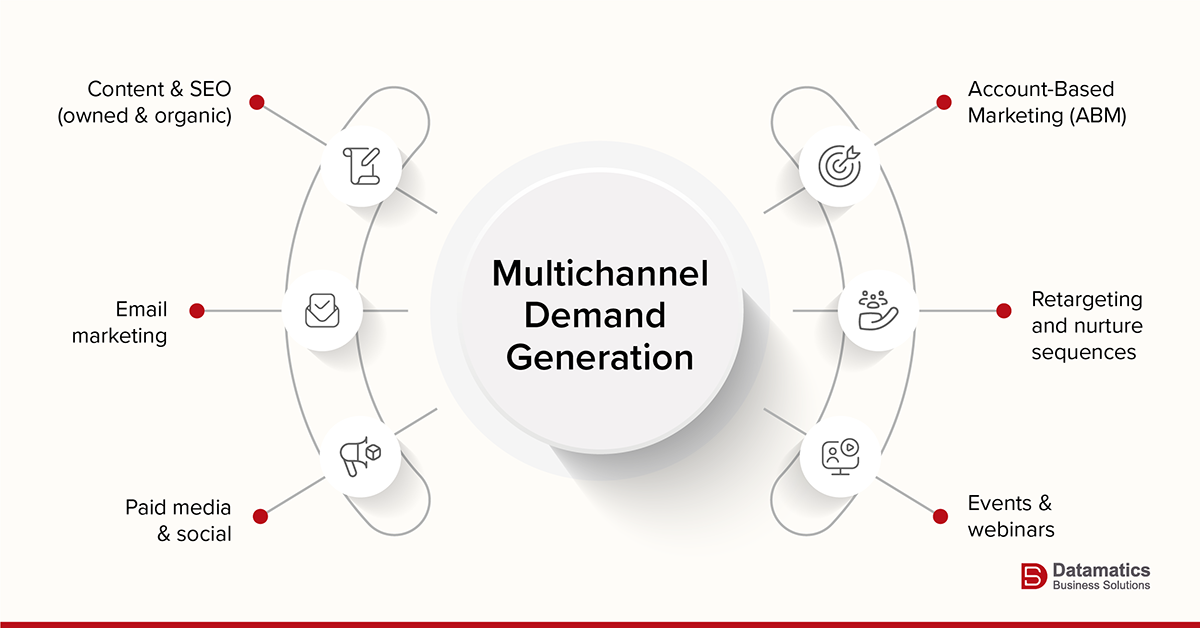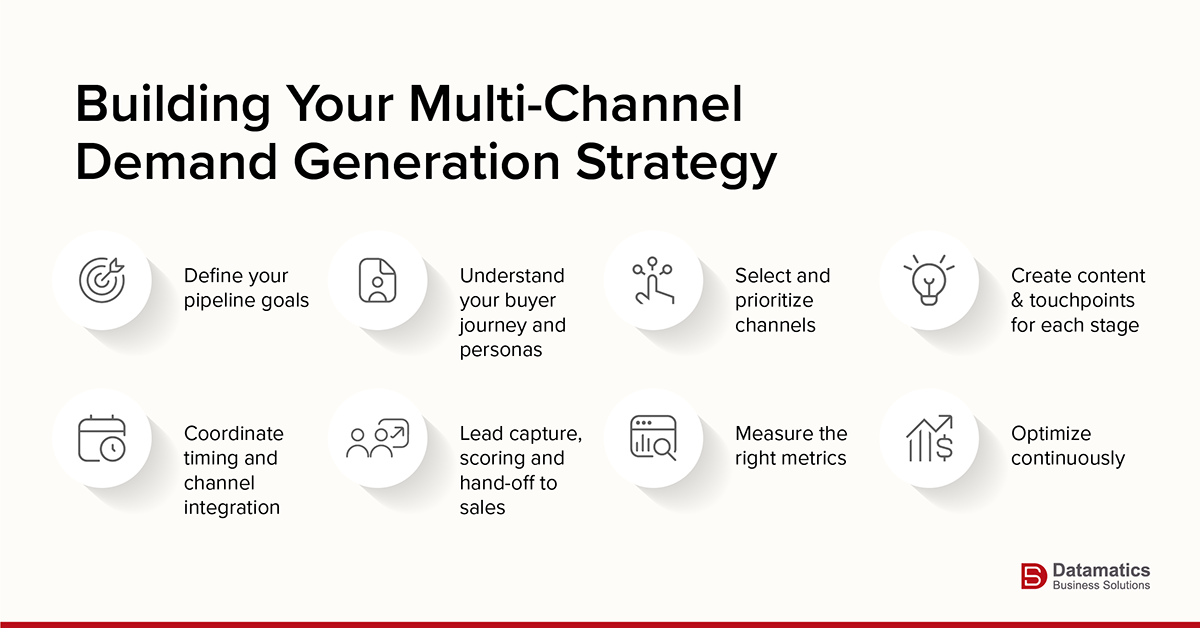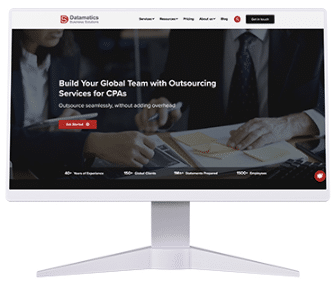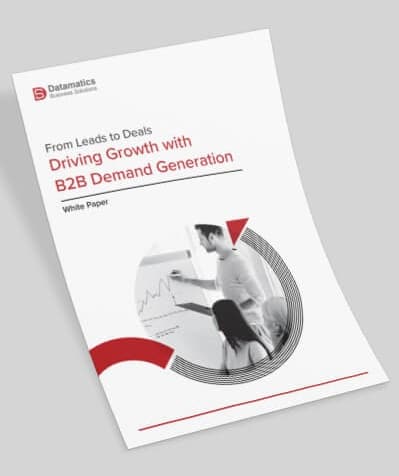Think about how you discovered your last business tool. Maybe you first saw a LinkedIn post about it, then read a blog review. You might have then joined a short webinar and finally decided to sign up after a follow-up email. That is how most modern B2B buyers behave. They don’t come from one channel. They come from many.
In fact, according to HubSpot, a typical B2B buyer engages with three to five different channels before ever talking to a sales rep.
In today’s crowded marketplace, simply relying on a single channel to generate interest isn’t enough. This is especially true for B2B businesses that depend on demand generation to build awareness, create interest, and turn prospects into a qualified pipeline that eventually converts into revenue.
But what exactly does demand generation mean. And how does it differ from the traditional lead generation? Keep reading to find out more.
What is Demand Generation?

“Demand generation” refers to all the marketing activities that drive awareness, interest, and early engagement with your product or service. Imagine you are opening a lemonade stall. Before people start buying, you hand out free samples, put up bright signs, and post about your stall on social media. You are not selling it yet. You are getting people curious and making them want a drink.
That is what demand generation does for a business – it builds awareness and interest before the sale happens.
It is safe to say, B2B demand generation goes beyond simply capturing leads or running ads. It is about putting your solution in front of the right people, in the right context, so that they move into your funnel when they are ready to buy.
In the B2B context, this means working across many touchpoints. This can include channels like content, email, paid social, SEO, events, account-based marketing, and more. According to one report, 80% of B2B marketers said that getting new, qualified leads is a mission-critical or urgent priority.
When you rely exclusively on one channel, say, only email or only paid ads; you risk missing the buyers who show up elsewhere or engage differently. Hence, the shift toward a multi-channel approach.
Key Takeaway
Demand generation is about creating interest and building a pipeline of potential prospects, not just grabbing leads.
You can also read: How does B2B Demand Generation Work?
Why Multi-Channel Matters in Demand Generation?
Multi-channel demand generation matters because today’s buyers interact with brands across many touchpoints — from social media to search to email. Using multiple channels ensures your message reaches them wherever they are, increasing visibility and conversion potential.
1. Buyers are active in many places
Modern buyers don’t follow a straight path. They might read a blog, see a LinkedIn post, download a whitepaper, attend a webinar, and then talk to sales. And all at different times and via different channels. A multi-channel demand generation strategy acknowledges this complexity.
For example, one study found that the top three lead generation channels for B2B marketers were – paid social (66%), email (64%), and display advertising (51%). If your strategy only focuses on one channel, you are ignoring large swathes of where prospects may be.
2. Combining channels improves funnel movement
Using a mix of channels means you can engage prospects at multiple stages: awareness, consideration, and decision. A blog may capture interest, a retargeted display ad may remind them, an email may deepen the engagement. All this helps move them into your pipeline.
In a 2025 survey, high-performing B2B marketing teams said they excelled in buyer engagement, content quality, sales-marketing alignment, and data usage. Those are all easier to do when multiple channels are coordinated.
3. Multi-channel supports better measurability and attribution
When you run campaigns across multiple channels, you gain more data points. You can see which channels generate high-quality leads, where drop-off happens, and where conversion to pipeline is strong. A study on demand generation metrics notes that one of the key metrics is pipeline velocity. With multi-channel demand generation strategy, you can link outcomes more effectively.
4. Buffering risk
If you rely on just one channel (e.g., only paid search) and that channel becomes more expensive or less effective due to regulation or competition, your pipeline suffers. Multi-channel gives you options and flexibility.
Key Takeaway
Choose a balanced mix of channels (earned, owned, paid) that align with your audience, message, and pipeline goals.
Recommended Reading: Top AI Tools that will Change Demand Generation
Key Channels to Include in Your Demand Generation Mix

Here are some of the major channels that make sense in a demand generation strategy:
- Content & SEO (owned & organic): Blogs, whitepapers, webinars, optimized site content, everything gets included in this. According to one source, 83% of organizations said content marketing was one of the top strategies for demand generation.
- Email marketing: Well-targeted and segmented email remains a staple. HubSpot reports show that 70% of marketers would rate their leads as high quality.
- Paid media & social: Paid social, display, search help you reach new audiences. The “State of B2B Pipeline Growth” report shows these channels were the most used lead generation channels.
- Account-Based Marketing (ABM): Especially in B2B, reaching specific accounts across channels (email, LinkedIn, events) helps create demand in target segments.
- Events & webinars: Both virtual and physical events give you high touch and engagement, good for the consideration stage.
- Retargeting and nurture sequences: Once someone has shown interest via one channel, using another channel to nurture them brings them closer to decision.
Importantly, it is not enough to include these channels. You must coordinate them, so they work together and not just run in silos.
Key Takeaway
Choose a balanced mix of channels (earned, owned, paid) that align with your audience, message, and pipeline goals.
How Multi-Channel Demand Generation Drives Pipeline Growth ?
We have already established that the benefits of multi-channel demand generation are many. When it comes to driving pipeline growth, such B2B demand generation tactics help reach prospects across multiple touchpoints. When channels work together, they build consistent engagement that turns casual interest into qualified opportunities for sales.
Here are the mechanics of how multi-channel demand generation works:
More qualified leads
With multiple channels, you expand your reach and increase the probability of capturing leads that match your buyer persona. A report showed that only 53% of marketers rated their lead quality as high or very high. By using multiple channels, you improve your chances of attracting higher quality leads.
Faster funnel progression
When a prospect experiences coordinated messaging across channels (for instance, a LinkedIn post, then an email, then a retargeted ad), the time they spend in “discovery” shrinks, and they are likely to move into a sales-ready state quicker. This improves pipeline velocity.
Improved coordination between sales and marketing
More data points and shared metrics between marketing and sales are made possible by multi-channel demand generation. It is simpler to agree on what constitutes good leads, where drop-offs occur, and how to make adjustments when both teams are aware of what is happening across channels. According to a poll, one of the main characteristics of high-performing teams is sales-marketing alignment.
Predictable growth
A well-orchestrated multi-channel strategy builds a systematic pipeline rather than random bursts. According to a report, marketers who added content syndication to their channel mix reported better lead generation goal attainment (61% vs 45%) when compared to those who didn’t. That kind of consistency helps forecasting and growth planning.
Improved measurement and optimization
When you have multiple channels, you can test, measure, and iterate. You might find channel A generates many leads but low conversion; channel B on the contrary can have fewer leads but higher conversion. Then you can shift budget and resources accordingly.
Key Takeaway
A coordinated multi-channel demand generation strategy generates more qualified leads, moves them faster through the funnel, and gives marketing and sales better alignment, leading to actual pipeline growth.
How to Build Your Multi-Channel Demand Generation Strategy

Building a multi-channel demand generation strategy starts with knowing where your audience spends their time and how they make decisions. By aligning the right mix of channels, content, and timing, you can create a steady flow of qualified leads into your pipeline.
Here is a step-by-step framework:
Step 1: Define your pipeline goals
What does pipeline growth mean for your organization? How much revenue do you need? How many opportunities are you looking for? What should be the individual deal size? Clear goals help prioritize channels.
Step 2: Understand your buyer journey and personas
Map out how your ideal buyer moves. Trace their journey right from awareness to purchase. Identify which channels they engage on, what their pain points are, what content they need at each stage.
Step 3: Select and prioritize channels
Based on your buyer journey and resources, pick a balanced set of channels such as owned (content, SEO), paid (ads, social), earned (PR, partner blogs), direct (email, events). Make sure you have a mix of top funnel and mid funnel channels.
Step 4: Create content and touchpoints for each stage
For the awareness stage, you can create content like blog posts, social posts, and paid ads that help drive traffic. For the consideration stage, you can rely on webinars, case studies, retargeting ads, and nurture emails. For the decision stage, include demos, trials, sales outreach, and account-based campaigns. Your messaging should be consistent yet adapted per channel.
Step 5: Coordinate timing and channel integration
Ensure channels talk to each other. For instance if someone reads a blog → they get an email with related content → they see a LinkedIn ad invite for a webinar → they attend. A unified experience matters.
Step 6: Lead capture, scoring and hand-off to sales
Define how leads are captured, how they are scored (MQL and SQL), and when they are handed to sales. Multi-channel campaigns should feed into a unified CRM/marketing-automation system.
Step 7: Measure the right metrics
Track metrics like website traffic, lead volume, conversion rates (MQL to SQL), pipeline velocity, cost per lead, cost per opportunity. Tracking the right metrics ensures you are on the right path.
Step 8: Optimize continuously
Use data to see what is working and what is not. Once you do this, adjust channels, messages, timing. If one channel shows weak conversion, test alternatives or refine your message. Multi-channels give you enough variety to optimize.
Key Takeaway
Follow a structured approach to your multi-channel demand gen approach. Define goals, map channels, create content, coordinate timing, measure, and optimize to ensure the best results.
You can also read: 6 Essential Elements of a Successful Demand Generation Strategy
Common Multi-Channel Demand Generation Mistakes to Avoid
Many demand generation efforts fail because channels work in silos or lack clear alignment with sales goals. Avoiding these mistakes ensures your efforts stay consistent, measurable, and focused on driving real pipeline growth.
- Operating channels in isolation — If your paid ads, email, and content team operate without coordination, you won’t get the full benefit.
- Not aligning sales and marketing — Lack of shared definitions and goals leads to pipeline loss.
- Overloading one channel — Putting all budget into one channel increases risk and limits reach.
- Poor measurement — If you can’t track how channels contribute, you can’t optimize.
- Weak content or irrelevant messaging — Without valuable content, multiple channels won’t move prospects.
- Ignoring data and feedback loops — Multi-channel only succeeds if you monitor and adjust.
Key Takeaway
Avoid channel silos, unclear alignment, insufficient measurement, and inconsistent messaging. For multi-channel to succeed, you need to ensure that all channels work in sync with each other.
Measuring Success of Multi-Channel Demand Generation (Downloadable Checklist)
Measuring success in multi-channel demand generation means looking beyond lead counts to track engagement, conversion, and pipeline impact. The goal is to understand which channels truly drive qualified opportunities and refine your strategy accordingly.
Here are some key metrics you should track. (Download the checklist and keep it handy for when you need it later!)
According to one study, 43 % of marketers still struggle to track and measure their metrics effectively in demand generation. This problem underlines how measurement remains a challenge and why building a proper multi-channel strategy helps you capture more data for optimization.
Key Takeaway
Use a mix of volume, quality and pipeline metrics; focus on funnel movement and cost efficiency to get the most out of your multi-channel demand generation approach.
How Datamatics Business Solutions Can Help with Demand Generation Services
The B2B space is highly competitive. Most companies often struggle to reach the right decision-makers, build awareness across channels, and convert interest into real opportunities. That’s where Datamatics Business Solutions steps in.
We offer B2B demand generation services that help companies create a predictable pipeline through data-driven targeting, high-quality leads, and consistent engagement across every stage of the buyer journey.
Our demand generation framework is built on intent-based marketing. We ensure that your campaigns focus on buyers who are already showing interest in your product or service. Instead of chasing cold prospects, we identify and engage audiences actively researching your industry, product category, or competitors. This ensures that your efforts go where it matters most.
At the heart of our offering is a diverse mix of multi-channel programs designed to suit different go-to-market goals. From content syndication to ABM, we engage multiple channels to drive demand gen efforts.
Every program we deliver is supported by analytics, performance tracking, and optimization. We provide full visibility into metrics such as lead quality, pipeline velocity, and campaign ROI, so you always know what is working and where to adjust. Our integrated approach ensures that marketing and sales work together seamlessly, enabling faster conversions and stronger revenue impact.
With a deep understanding of global B2B markets and experience executing programs across industries, we offer B2B demand generation services in the USA that are both scalable and predictable. Whether you are building awareness, targeting key accounts, or nurturing high-intent buyers, our team helps you turn demand into measurable growth.
In short, we don’t just run campaigns. We build a connected demand generation system tailored to your business goals. With intent-based targeting, precise lead qualification, and multi-channel execution, we help you fill your pipeline with opportunities that convert and relationships that last.
Interested in learning more about our intent-based demand generation services? Fill out this form and get in touch with our experts.
Conclusion
Today, buyers are everywhere. They are always searching, reading, comparing, and evaluating. And they employ multiple channels before ever reaching out to sales. Relying on a single marketing channel is no longer enough to stand out. A multi-channel demand generation strategy ensures that your message reaches the right people, at the right time, in the right place.
When done right, such demand generation tactics can help contribute massively to your pipeline growth.
Want more of such informative pieces delivered to your inbox? Subscribe to our newsletter and stay on top of the latest trends
FAQs
Q1. What’s the difference between demand generation and lead generation?
Demand generation is a broader concept. It focuses on creating interest, awareness, engagement, and eventually providing pipeline opportunities. Lead generation, on the other hand, is more specifically about capturing leads (contact information) with the intention of converting them. Demand generation covers more of the buyer’s journey before they are ready to buy.
Q2. How many channels should I include in my demand-generation strategy?
There is no fixed number. The right number depends on your audience, budget and resources. What matters is that you have a mix of owned, earned and paid channels, and that they are coordinated rather than operating in silos.
Q3. How long does it take to see pipeline growth from a multi-channel strategy?
It depends on your sales cycle, industry, offer, and how well your channels and content are aligned. Some results (e.g., increased traffic or engagement) can show up within weeks; whereas meaningful pipeline growth may take months. The key is measurement, iteration, and consistency.
Q4. What metrics should I focus on first?
Start with metrics across awareness, engagement, and conversion. For example, website traffic (new and repeat), lead volume, conversion rate from visitor to lead, MQL to SQL rate, pipeline value, and velocity. Then dive deeper into channel-specific metrics and cost per lead. Tracking these can help you avoid from “flying blind.”
Q5. How do I ensure my channels work together rather than compete
Set a unified strategy and messaging, establish a channel map that shows how each channel supports the buyer journey. You should also use consistent branding and offer, set shared KPIs across channels, and use a common CRM so you can see results across channels. Encourage collaboration between content creators, media buyers, email teams and sales.
Q6. Is multi-channel always worth the cost?
Yes. If done well. Multi-channel increases reach, supports funnel progression, improves measurement, and reduces risk. But it requires clear coordination, measurement, and content. If you just add channels without planning or integration, you may waste budget and introduce complexity.

Carly Jaspan




